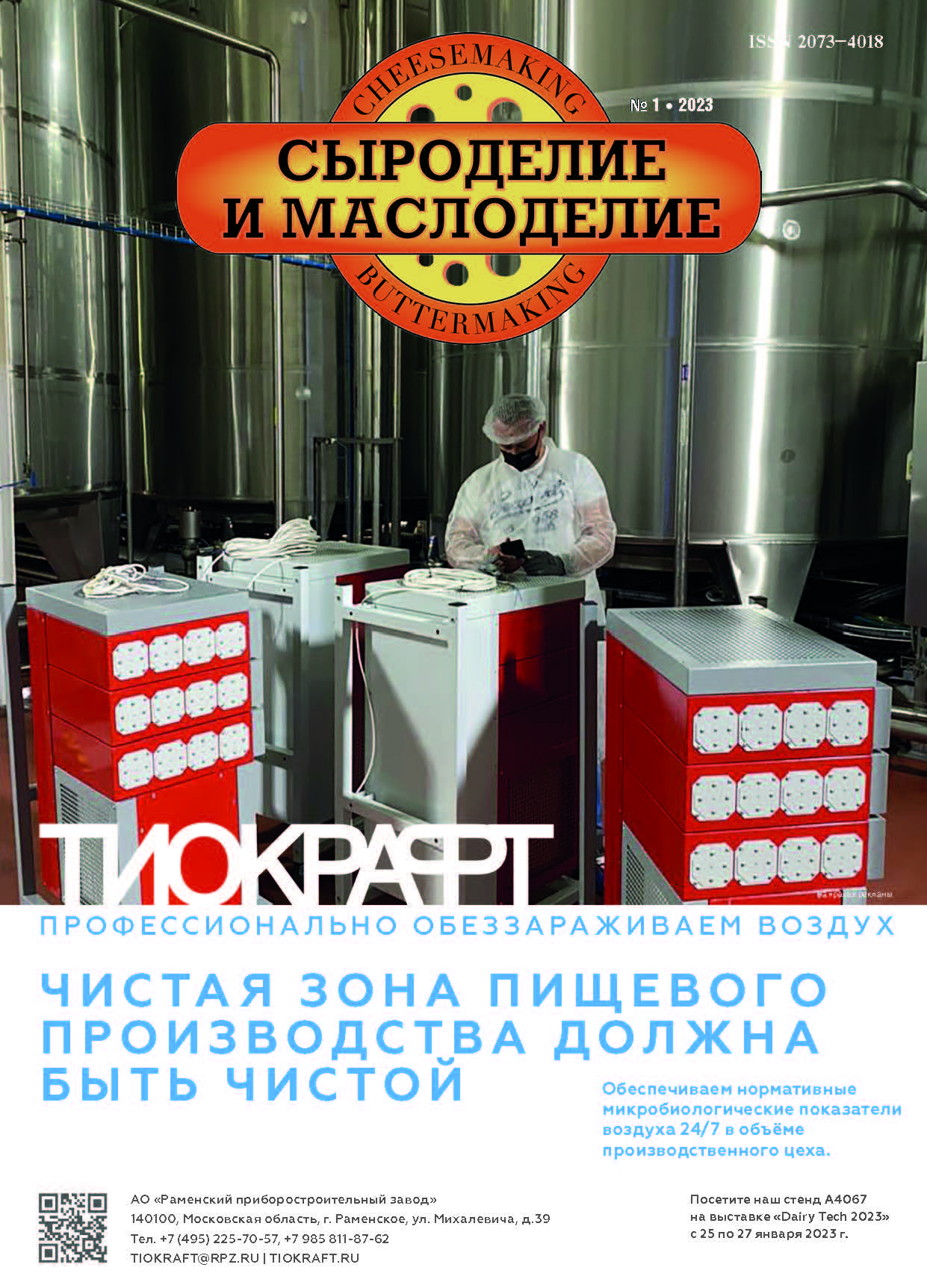Barnaul, Russian Federation
Polzunov Altai State Technical University
Barnaul, Barkaul, Russian Federation
Barnaul, Russian Federation
Barnaul, Russian Federation
Barnaul, Russian Federation
Barnaul, Russian Federation
Barnaul, Barkaul, Russian Federation
The milk-clotting and general proteolytic activity of an engineered variant of recombinant reindeer chymosin (Rangifer tarandus) with a point amino acid replacement Lys53→Glu was studied. Commercial recombinant cow and single-humped camel chymosins were used as comparison enzymes. It is shown that the total proteolytic activity of the engineered variant of reindeer chymosin is 36 % lower than that of recombinant cow chymosin. The engineered version of recombinant reindeer chymosin was characterized by extremely low relative milk-clotting activity, which led to a decrease in its specificity, compared with recombinant cow and camel chymosins by 2,4 and 9,8 times respectively.
reindeer, chymosin, recombinant chymosin, milk-clotting activity, proteolytic activity, cheesemaking
1. Cheese: chemistry, physics and microbiology. 4th edn., Chapter 4 - Chymosin, pepsins and other aspartyl proteinases: structures, functions, catalytic mechanism and milk-clotting properties / T.Uniacke-Lowe, P.F.Fox.; P.L.H.McSweeney, P.F.Fox, P.D.Cotter et al., eds. - Oxford, UK: Elsevier, Academic Press. 2017. P. 69-113.
2. Kappeler, S.R. Characterization of recombinant camel chymosin reveals superior properties for the coagulation of bovine and camel milk / S.R.Kappeler [et al] // Biochem. Biophys. Res. Comm. 2006. V. 2. N. 342. P. 647-654.
3. El'chaninov, V.V. Molokosvertyvayuschiy ferment iz sychugov severnogo olenya / V.V. El'chaninov // Syrodelie i maslodelie. 2006. № 4. C. 42-44.
4. El'chaninov, V.V. Issledovanie molokosvertyvayuschego fermenta iz sychugov severnyh oleney: dis. … kand. tehn. nauk: 05.18.04: zaschischena 23.01.06: utv. 07.04.06 / El'chaninov Vadim Valentinovich. - Kemerovo, 2006. - 172 s. Bibliogr.: S. 121-147.
5. Jensen, J.L. Camel and bovine chymosin: the relationship between their structures and cheese-making properties / J.L.Jensen [et al.] // Acta Cryst. (Section D, Biol. Crystallogr.). 2013. V. 69. Pt. 5. P. 901-913.
6. Bradford, M.M. A rapid and sensitive method for the quantitation of microgram quantities of protein utilizing the principle of protein-dye binding / M.M.Bradford // Anal. Viochem. 1976. V. 72 (1-2). P. 248-254.
7. El'chaninov, V.V. Molokosvertyvayuschiy ferment iz sychugov severnogo olenya. 1. Vydelenie i kratkaya harakteristika / V.V.El'chaninov [i dr.] // Syrodelie i maslodelie. 2005. № 4. S. 13-16.
8. Singh, T.K. Flavor of Cheddar Cheese: A Chemical and Sensory Perspective / T.K.Singh, M.A.Drake, K.R.Cadwallader // Compr. Rev. Food Sci. Food Safety. 2003. V. 2. № 4. P. 139-162.
9. Harboe, M. In: Technology of Cheesemaking. Law B.A., Tamime A.Y., Eds. / M.Harboe, M.L.Broe, K.B.Qvist // Wiley-Blackwell. Ch. 3. The Production, Action and Application of Rennet and Coagulants. 2010. P. 98-129.
10. Murunova, G.V. Principy podbora molokosvertyvayuschego fermenta dlya proizvodstva syra / G.V.Murunova, Yu.Ya.Sviridenko // Syrodelie i maslodelie. 2006. № 5. S. 2-5.
11. Teply, M. Molokosvertyvayuschie fermenty zhivotnogo i mikrobnogo proishozhdeniya / M.Teply, Ya.Mashek, Ya.Gavlova. - M.: Pischevaya promyshlennost', 1980. -272 s.
12. Wei, C. Oxidative refolding of recombinant prochymosin / C.Wei [et al.] // Biochem. J. 1999. V. 340. P. 345-351.
13. Chen, H. Functional Implications of Disulfide Bond, Cys206-Cys210, in Recombinant Prochymosin (Chymosin) / H.Chen [et al.] // Biochemistry. 2000. V. 39. P. 12140-12148.
14. Wei, C. Chaperone-mediated refolding of recombinant prochymosin / C.Wei, Y.Zhang, K.Yang // J.Prot. Chem. 2000. V. 19. N. 6. P. 449-456.
15. Eskandari, M.H. Cloning, Expression, Purification and Refolding of Caprine Prochymosin / M.H. Eskandari [et al.] // Food Biotechnol. 2012. V. 26. № 2. P. 143-153.
16. Belen'kaya, S.V. Nekotorye biohimicheskie svoystva rekombinantnogo himozina al'paka (Vicugna pacos L.) / S.V.Belen'kaya [i dr.] // Prikladnaya biohimiya i mikrobiologiya. 2018. T. 54. № 6. S. 585-593.






